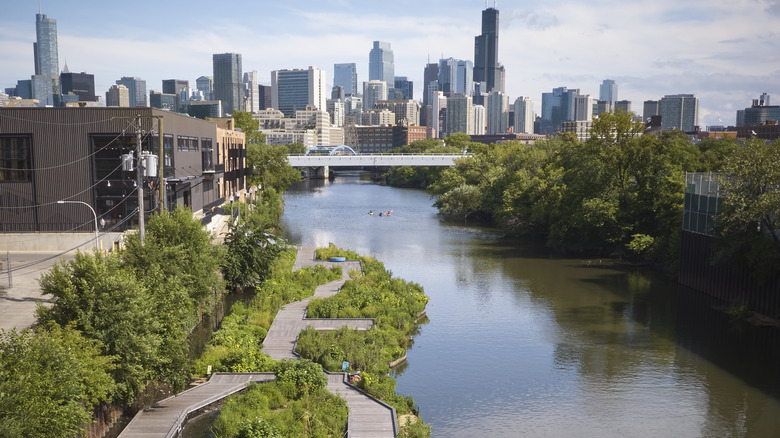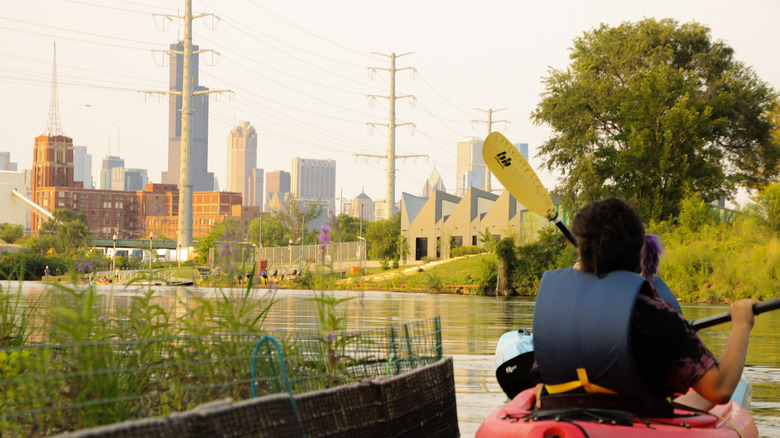
According to Choose Chicago, an estimated 55 million travelers visit Chicago each year, drawn to its architecture, world-class museums, and, of course, its Chicago-style hot dogs. Now, there's a new reason to visit the Windy City: The Wild Mile, the world's first floating eco-park. This biodiverse nature sanctuary is designed to turn the industrialized River North neighborhood into an urban green space for recreation, education, environmental cleanup, and wildlife preservation.
The Wild Mile is an
innovative feat of ecological engineering. Buoyant, garden-like modules are linked along a northern stretch of the canal, each planted with native Illinois vegetation to replicate a riparian habitat — a wetland zone along the edge of a waterway. The floating habitats are anchored to the seawall and the riverbed by a root system, which also serves as underwater shelter for fish, freshwater mussels, and other aquatic species. This ecosystem helps absorb rainwater, so as the water levels in the canal fluctuate, the Wild Mile can "ride the tide," mitigating flood risk. Submerged portions of the structures also transform naturally occurring phosphorus and nitrogen, enhancing plant growth while reducing soil erosion, runoff, and toxic algae blooms. Freshwater mussels act as biofilters, absorbing contaminants and improving water quality.Today, the Wild Mile is home to nearly 60 wetland species, including bees, turtles, muskrats, and fish. The 10,000 native plants help sustain and support the wildlife by providing spawning and nesting areas, shelter, and food. The park is free and open to the public 24/7, with a 700-foot long, ADA-accessible boardwalk made of sustainable pine. You can access Wild Mile behind the REI on West Eastman Street, about 2.5 miles from Ogilvie Transportation Center, or an 8-minute walk from the transit station at Division and Halstead streets.
Read more: The 14 Best Botanical Gardens In America, According To Reddit
The Wild Mile Is A Model Of Ecological Innovation For Other Cities

Wild Mile is a collaborative effort from Urban Rivers -- a nonprofit committed to "transforming cities into urban sanctuaries" -- along with city leaders, architectural firms, and the Shedd Aquarium, to revitalize the River North area and long-polluted canals. The project broke ground in 2021 and opened its first 400 feet of park and trail to the public in 2022. The park added another 300 feet in 2024, with plans to expand to a full mile. The Wild Mile also promotes community mindfulness and uses the space for education and art, hosting workshops and field trips year-round.
Chicago canals were built in the 1850s, initiated under the city's first mayor, as a way to move barges and boats of industrial goods through the city from Goose Island. As industrial uses declined and shipping along the canals decreased, the polluted concrete-and-steel waterways stagnated, creating hostile conditions for natural ecosystems. For years, there was no feasible way to restore or repurpose them. Now, as a former "manufacturing metropolis," it's inspiring to see the transformation of some of Chicago's grittiest spaces into eco-zones, healthy green spaces, and "living laboratories." The Lincoln Park Conservatory is another urban oasis in Chicago, a free garden and park right in the center of one of Chicago's oldest neighborhoods.
If you're interested in getting involved, Urban Rivers offers volunteer opportunities as River Rangers, helping maintain habitats and cleaning up trash by land or kayak. The Wild Mile also has a public-access kayak dock where you can launch your own boat, or rent one from nearby Kayak Chicago for $30 per hour or $90 per day, as of this writing.
Ready to discover more hidden gems and expert travel tips? Subscribe to our free newsletter for access to the world's best-kept travel secrets.
Read the original article on Islands.











